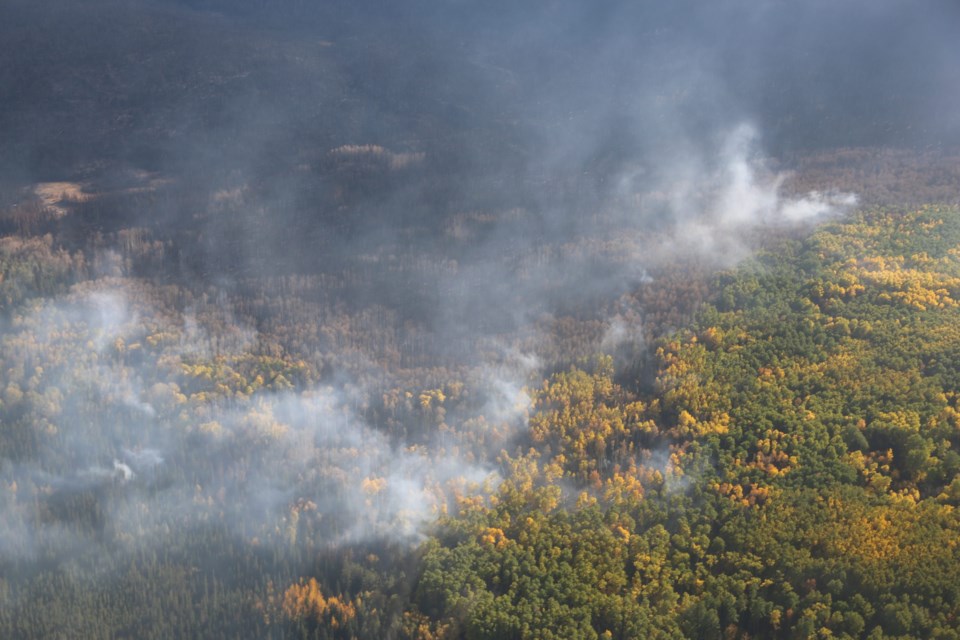Scott Hayes, Local Journalism Initiative Reporter | [email protected]
As the Chetamon Wildfire area continues to smoulder into the valleys off of its western flank, Parks CanadaÔÇÖs crews are keeping their eyes on the scorched and smoking landscape.
Crews are also paying mind to the weather patterns above, as Jasper continues to experience an uncommonly hot and dry weather pattern. 
Katie Ellsworth, fire management officer in Jasper National Park, said the big difference in the environment linked to climate change would lead to more dramatic weather events and more wildfires.
ÔÇťWe have recorded similar temperatures in other autumns ÔÇô 2006 was quite warm, 2014 was quite warm. These periods also had no precipitation. We are seeing that again,ÔÇŁ she said.
ÔÇťThe models do indicate that climate change will lead to longer, hotter and drier periods, which then could in turn lengthen the fire season overall.ÔÇŁ
Environment and Climate Change Canada (ECCC) meteorologist Kyle Fouge╠Çre offered a quick recap of JasperÔÇÖs weather over the last few months.
ÔÇťWe've had a consistent weather pattern, since roughly the second week of July, where we've been seeing consistently above normal temperatures due to a ridge of high pressure that's been omnipresent over western North America,ÔÇŁ he said.
ÔÇťThere have been a couple of periods where temperatures have briefly dipped below normal, but for the most part, we've been sitting above normal from the middle of summer onwards.ÔÇŁ
ECCC has 13 sites that record climate statistics across the province, excluding Jasper. Fougère said that 10 of those sites experienced their top 10 warmest Septembers ever, while all 13 of them were in their top five warmest Augusts of all time.
Jasper had 17 days of 30 C or hotter over the course of the summer, with another two days in September. The wildfire did knock out the power to the weather station for several days, so itÔÇÖs possible that Jasper saw other high temperatures that month.
Temperatures have continued to be above normal with the exception of a cold front that came through on Oct. 10.
For reference this time of year, Fougère said Jasper typically sees a daytime high of about 9 C and an overnight low of about -1 C. Temperatures for most of this last week went up to the high teens, with 26.5 C being recorded on Oct. 3 and -6.3 C being recorded overnight on Oct. 17.
Jasper has seen only 23.1 millimetres of precipitation since Sept. 1. 
ÔÇťParks Canada is working hard to integrate climate change mitigations and adaptations into our framework,ÔÇŁ Ellsworth said.
ÔÇťWe're trying hard to work it into how we're being prepared for the fire season, how we're working forward within our management plan objectives as well.ÔÇŁ
Part of that strategy is to let the wildfire continue to burn off excess fuels toward the west and into the Snake Indian Valley.
ÔÇťParks Canada does see fire as a natural ecosystem-driven process,ÔÇŁ Ellsworth said. ÔÇťIt's an essential element like the rain and the snow.ÔÇŁ
Parks has evaluated that specific region to be in the intermediate zone, meaning that the ecological benefits due to fire outweigh the potential negative impacts for safety and other considerations. 
The expected result of this is what Parks calls a ÔÇťheterogeneous landscape.ÔÇŁ
ÔÇťIt'll look like a quilt, essentially, with different patches of different age class [trees] within a standard area, as opposed to what you see out there right now, which is kind of a consistent age class with just pine fuels, which are ready to go because they're getting towards the end of their lifecycle,ÔÇŁ Ellsworth said.




